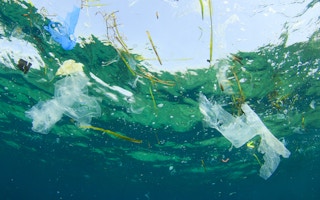Scientists have fretted over the expanding masses of plastic in the ocean for decades. Most have seen the rise with their own eyes, and yet the available datasets typically don’t stretch back far enough to capture the trend.
That all changed with a new study, published April 16 in the journal Nature Communications, covering 60 years of plastic snagged by a plankton sampling device. The research shows, for the first time, a significant increase in plastic in the open ocean.
“Though it’s exactly what we expected, it really kind of hammered home — this is real,” Clare Ostle, a marine biogeochemist at the University of Plymouth in the U.K., said in an interview.
From the great ocean gyres that gather huge marine “garbage patches” to the ubiquity of microplastics — tiny fragments left behind when our waste splinters in sunlight or saltwater — the past few decades have seen a “big wave of marine litter research,” Lars Gutow, a marine ecologist at the Alfred Wegener Institute Helmholtz Centre for Polar and Marine Research in Bremerhaven, Germany, told Mongabay.
“We see that the amount of plastics being produced every year is increasing exponentially, but we have no data that show this actual accumulation of marine litter in the environment,” said Gutow, who studies marine litter but was not involved in the current study.
It’s difficult to go back in time, before swarms of floating trash were a recognised problem, and track the buildup of garbage in the ocean — difficult, but not impossible, at least in a sense, Ostle found. The University of Plymouth has a fleet of 53 continuous plankton recorders, or CPRs, that commercial ships tow behind them to gather plankton samples, mostly in the North Atlantic Ocean. Over the 60 years of this study, those ships have plowed through around 12 million kilometres (5 million nautical miles).
British zoologist Alister Hardy invented the CPR to systematically keep tabs on plankton. Since the first tow in 1931, its design, employing a moving band of silk to trap plankton over great distances, has changed little, and it’s proven to be a workhorse, reliably gathering samples as it’s towed at speeds of up to 25 knots (29 miles per hour), sometimes through rough seas.
A few years ago, the workshop team in charge of keeping the CPRs functioning began noticing that more trash was gumming up the silken bands.
“
We see that the amount of plastics being produced every year is increasing exponentially, but we have no data that show this actual accumulation of marine litter in the environment.
Lars Gutow, marine ecologist, Alfred Wegener Institute Helmholtz Centre for Polar and Marine Research
“That’s really where I said, ‘Well, let’s look back through the historical log books and see how these have been tracked through time,’” Ostle said.
And in an entry from 1957, she found what she was looking for: the CPR’s first recorded entanglement with a length of twine used by fishing trawlers. The timing made sense because that was around the time fishers began to switch over to synthetic nets and lines as cheaper and more efficient alternatives to the natural materials they had been using for centuries.
Then, in 1965, the CPR ensnared a second piece of plastic, a bag off Ireland’s coast. From that point forward, the logbooks from ongoing plankton research catalog first a trickle and then a flood of entanglements with the CPR.
Ostle and her coauthors note that the CPR travels through the water in a way that is similar to the way marine animals move, and so it faces similar entanglement threats. Indeed, she said, sea birds and turtles start showing up in the scientific literature in the 1960s. In their analysis of the recorded entanglements, the researchers found that a lot of that plastic was old or discarded fishing gear, especially after 2000. Plastic bags, on the other hand, have shown up less frequently since the turn of the century.
The changing mix of plastic types could be because fishing gear is designed to snag things moving through the water, the authors say, so it’s more prone to getting hung up on the CPR. It also could be that fewer single-use bags are turning up because laws and social norms that discourage their use may be having an impact, Ostle said.
“People are really starting to notice and become much more aware of their use of plastics,” she said.
She was quick to caution that these data from chance encounters aren’t quantitative, meaning they can’t accurately assess the amount of plastic floating in the ocean. Instead, she describes it as “semi-quantitative,” representing a sample of a kind of litter that’s prone to catch on the CPR in a relatively small patch of the Atlantic Ocean.
“They are reporting about accidents in a way,” Gutow said. Still, he said of the research, “It’s great. We need more of it.”
He said it provides a “clear example” of the rise in plastic litter fouling the ocean over time.
“I find it conclusive,” Gutow said. “I expected it. I think everybody expected it, but we couldn’t show it before.”
He and Ostle both point out the importance of getting rid of the “ghost nets” and other fishing gear that proves so deadly to whales, turtles and other sea life. Gutow said he sees the issue of plastic in the ocean is linked to other ways we humans impact the ocean.
“It is closely connected to other anthropogenic stressors,” he said. “I think it is important to see this, to have a holistic view on the effect of humans on the marine ecosystems.” Without that approach, he added, it’s unlikely we’ll be able to solve the problems that plague them.
This story was published with permission from Mongabay.com.










